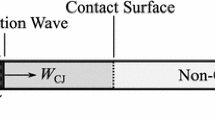Abstract
A chemical shock tube driven by a detonation driver is described in the present paper. This shock tube can produce a single controlled high-temperature pulse for studies of gas-phase reaction kinetics, but the difficulty associated with the timing for the rupture of diaphragms in the conventional chemical shock tube is overcome, because the detonation wave in the driver section can be predicted correctly and shows a good repeatability. In addition, this shock tube is capable of providing higher temperature conditions for the test gas than the conventional high-pressure shock tube, owing to the inherently high-driving capability of the detonation driver. The feasibility of this shock tube is examined by numerical simulations and preliminary experiments.
Similar content being viewed by others
References
Greene E.F., Taylor R.L., Patterson W.L. Jr: Pyrolysis of simple hydrocarbons in shock waves. J. Phys. Chem. 62, 238–243 (1958)
Marshall R., Davidson N.: Photoelectric observation of the rate of recombination of iodine atoms. J. Chem. Phys. 21, 659–664 (1953)
Glick, H.S., Squire, W., Hertzberg, A.: A new shock tube technique for the study of high temperature gas phase reactions. In: The Fifth (International) Symposium on Combustion, Pittsburg, Pennsylvania, August 30–September 3, 1954, pp. 393–402. Reinhold, New York (1955)
Lifshitz A., Bauer S.H., Resler E.L.: Studies with single-pulse shock tube. I. The cis-trans isomerization of betene-2. J. Chem. Phys. 38, 2056–2063 (1963)
Fang B.C., Cui J.P.: Single-pulse tube with a magic hole. Aerodyn. Exp. Meas. Control 4, 58–62 (1990)
Bird, G.A.: A note on combustion driven shock tubes. AGARD Report No. 146 (1957)
Lee B.H.K.: Detonation driven in a shock tube. AIAA J. 5(4), 791–792 (1967)
Yu H.R., Esser B., Lenartz M., Groenig H.: Gaseous detonation driver for a shock tunnel. Shock Waves 2(4), 245–254 (1992)
Erdos, J.I., Bakos, R.J., Rogers, R.C.: Dual mode shock expansion/reflected-shock tunnel. AIAA Paper 97-0560 (1997)
Lu F.K., Wilson D.R., Bakos R.J., Erdos J.I.: Recent advances in detonation techniques for high-enthalpy facilities. AIAA J. 38(9), 1676–1684 (2000)
Fickett W., Davis W.C.: Detonation Theory and Experiment. Dover, Mineola (1979)
Olivier, H., Jiang, Z.L., Yu, H.R.: Detonation-driven shock tubes and tunnels. Advanced hypersonic test facilities. In: Lu, F., Marren, D. (eds.) Progress in Astronautics and Aeronautics, vol. 198, pp. 135–205. AIAA (2002)
Lifshitz, A.: The Single Pulse Shock: Its Odyssey in Chemical Kinetics. In: Jiang, Z. (ed.) Proceedings of the 24th International Symposium on Shock Waves, pp. 57–64, Beijing, July 11–16, 2004 (2004)
Gaydon A.G., Hurle I.R.: The Shock Tube in High-Temperature Chemical Physics. Chapman and Hall, London (1963)
Reynolds, W.C.: The Element Potential Method for Chemical Equilibrium Analysis: Implementation in the Interactive Program STANJAN, Version 3. Mechanical Engineering Department, Stanford University (1986)
Li J.P., Feng H., Jiang Z.L.: Numerical computation on the tailored shock mach numbers for a hydrogen-oxygen detonation shock tube. Acta Aerodyn. Sin. 26(3), 291–296 (2008)
Li J.P., Jiang Z.L., Chen H.: Numerical study on backward- forward double detonation driver for high-enthalpy shock tubes. Chin. J. Theor. Appl. Mech. 39(3), 343–349 (2007)
Jiang Z.L., Takayama K., Chen Y.S.: Dispersion conditions for non-oscillatory shock capturing schemes and its applications. Comput. Fluid Dyn. J. 4(2), 137–150 (1995)
Sichel M., Tonello N.A., Oran E.S., Jones D.A.: A two-step kinetics model for numerical simulation of explosion and detonation in H2–O2 mixtures. Proc. R. Soc. Lond. A 458, 49–82 (2002)
Zhang X.Y., Yu H.R.: Turbulent Jet Initiation of Oxy-hydrogen Direct Detonation. Aerodyn. Exp. Measur. Control 10(2), 63–68 (1996)
Hertzberg A., Glick H.S.: Kinetics studies in a single-pulse shock tube. In: Ferri, A. (ed) Fundamental Data Obtained from Shock-Tube Experiments, pp. 161–182. Pergamon Press, London (1961)
Author information
Authors and Affiliations
Corresponding author
Additional information
Communicated by H. Olivier.
Rights and permissions
About this article
Cite this article
Li, J., Chen, H. & Yu, H. A chemical shock tube driven by detonation. Shock Waves 22, 351–362 (2012). https://doi.org/10.1007/s00193-012-0374-y
Received:
Revised:
Accepted:
Published:
Issue Date:
DOI: https://doi.org/10.1007/s00193-012-0374-y




